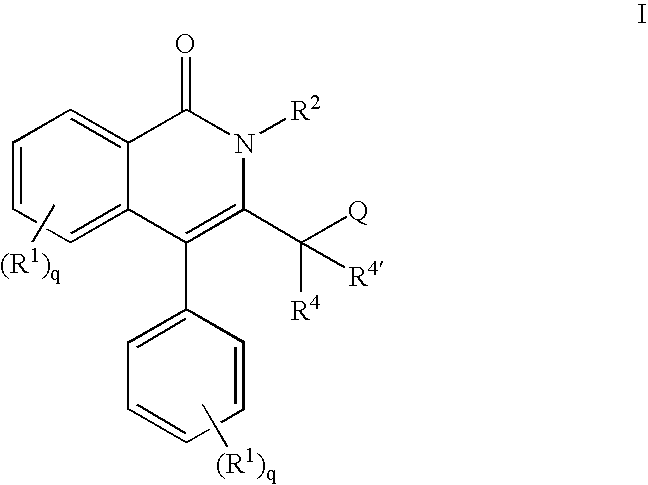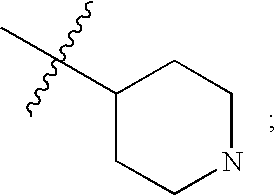Isoquinolinone potassium channels inhibitors
a potassium channel inhibitor and isoquinolinone technology, applied in the field of isoquinolinone compounds, can solve the problems of congestive heart failure, unclear physiologic role of particular channels, and prolongation of electrical action potentials or membrane potential depolarization
- Summary
- Abstract
- Description
- Claims
- Application Information
AI Technical Summary
Benefits of technology
Problems solved by technology
Method used
Image
Examples
example 1
EXAMPLE 2
4-Methoxy-N-methyl-benzamide (8)
An addition funnel containing p-anisoyl chloride (47.6 g, 279 mmol) and methylene chloride (125 mL) was attached to a 2 L 3-neck round bottom flask containing 375 mL methylene chloride. The reaction flask was cooled in an ice bath and methylamine (g) was bubbled through the solvent. The contents of the addition funnel were added dropwise. A white precipitate appeared. Warmed to room temperature and stirred for 24 h. Washed with water; separated layers and dried the organic portion with sodium sulfate (anh.). Removal of the solvent in vacuo followed by trituration with hexane / ether gave 8 as a white solid (33.7 g, 204 mmol, 73.2%)
1HNMR (CHCl3, 300 MHz) δ 7.80 (d, 2H); 6.95 (d, 2H); 6.10 (s, br, 1H); 3.85 (s, 3H), 3.00 (d, 3H).
example 3
5-Methoxy-3-phenyl-3H-isobenzofuran-1-one (9)
A solution of 8 (15 g, 91 mmol) in THF was cooled to −70° C. under Argon. To this was added sec-butyllithium (147 mL, 1.3M). After stirring 0.5 h a tan suspension resulted. Added benzaldehyde (9.2 mL, 91 mmol.) and stirred 1 h. Quenched with ice then removed THF in vacuo. Added sat. sodium bicarbonate and extracted with ethyl acetate (4×). Dried the combined organic portions with sodium sulfate (anh.) and removed the solvent in vacuo. Added toluene and heated to reflux for 18 h. Removal of the solvent in vacuo followed by trituration with hexane / ether gave unreacted starting material 8 (4.63 g). Concentration of the filtrate in vacuo followed by flash column chromatography (hexane:ethyl acetate 80:20) gave 9 as a yellow solid (12.0 g, 50.1 mmol, 55.1%)
1HNMR (CHCl3, 300 MHz) δ 7.90 (d, 1H); 7.40-7.20 (m, 4H); 7.05 (d, 1H); 6.75 (s, 1H), 6.30 (s, 1H); 3.82 (s, 3H).
example 4
2-Benzyl-4-methoxy-benzoic acid (10)
To a solution of 9 (12.0 g, 50 mmol) in ethanol was added 10% palladium on carbon (1.5 g). The resulting suspension was hydrogenated at 60 psi for 18 h. Filtration through celite followed by removal of the solvent in vacuo gave 10 as a white solid (11.0 g, 45.5 mmol, 91.1%).
1HNMR (CHCl3, 300 MHz) δ 8.10 (d, 1H); 7.40-7.20 (m, 5H); 6.81 (d, 1H); 6.70 (s, 1H), 4.42 (s, 2H); 3.90 (s, 3H).
PUM
| Property | Measurement | Unit |
|---|---|---|
| cell membrane potential | aaaaa | aaaaa |
| ion movement | aaaaa | aaaaa |
| electrical action potential | aaaaa | aaaaa |
Abstract
Description
Claims
Application Information
 Login to View More
Login to View More - R&D
- Intellectual Property
- Life Sciences
- Materials
- Tech Scout
- Unparalleled Data Quality
- Higher Quality Content
- 60% Fewer Hallucinations
Browse by: Latest US Patents, China's latest patents, Technical Efficacy Thesaurus, Application Domain, Technology Topic, Popular Technical Reports.
© 2025 PatSnap. All rights reserved.Legal|Privacy policy|Modern Slavery Act Transparency Statement|Sitemap|About US| Contact US: help@patsnap.com



